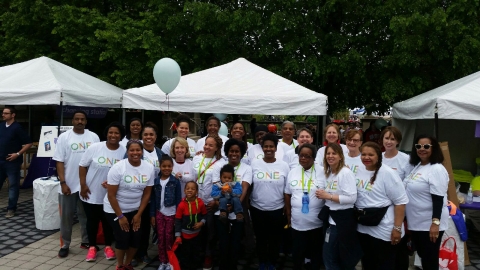Healthy Counties: Fostering Better Health Outcomes in Children and Older Adults
Upcoming Events
Related News
Jump to Section |

|
SnapshotBest Starts for Kids in King County invests in promotion, prevention and early intervention for children, youth, families and communities by providing caregivers with tools to ensure that children in King County develop the basic skills necessary to thrive. |
The Opportunity for Change
Scientific research indicates that prevention and early intervention are the most effective and least expensive way to put children and youth on a path toward lifelong success. However, King County noticed that by the time it responded to negative outcomes in the community, there weren’t enough resources available to invest in proven prevention strategies. Through a county-wide levy, Best Starts for Kids provides resources to invest early in the development of children in King County to deliver the greatest returns and confront the region’s growing inequities.
King County’s Model
King County established an oversight and advisory board made up of county residents and stakeholders with geographically and culturally diverse perspectives. The advisory board makes recommendations and monitors distribution of levy proceeds.
Best Starts for Kids strategies are designed to be both universal and targeted, with the large majority of levy funding competitively bid in outcomes-based contracts to community organizations. King County voters approved the initiative in November 2015, resulting in a six-year levy, which raises about $65 million per year and costs the average King County homeowner about $1 per week.
The revenue is divided to support the program’s guiding principles.
- Fifty percent of the revenue is invested in strategies focused on children under age five and pregnant women, including a investment to sustain and expand parent and child health services delivered through the county’s public health centers. The evidence demonstrates that the earlier investments are made, the greater the return for both the child’s development and society.
- Thirty-five percent is invested in strategies focused on children and youth aged five through 24. Research indicates that the brain continues to develop during this time and that prevention efforts addressed at key developmental stages or transition points in a young person’s life help to sustain gains made earlier in life.
- Ten percent is invested in strategies to create safe and healthy communities, based on research and evidence regarding the impact of place on a child’s success and the importance of supporting communities in building their capacity to create change.
- Five percent supports data collection and evaluation, as well as staffing infrastructure. This allows the King County to track progress and ensure that programs are creating outcomes that improve health and well-being in the county.
The county is using initial levy collections to create a family and youth homelessness prevention initiative modeled on a successful pilot implemented by the Washington State Coalition against Domestic Violence and funded by the Bill & Melinda Gates Foundation. [END OF GRAPHIC]
Successes and Outcomes
- Best Starts for Kids is expected to reduce inequities in King County and create healthy communities that reinforce this progress.
- Through focus groups, community listening sessions across the County and individual meetings, King County has connected with over 1,000 people to gain information from the community and inform the implementation plan.
- In January 2016, a Children and Youth Advisory Board was appointed to make recommendations and monitor distribution of levy proceeds.
“This is a victory for children, youth and families across King County—and our opportunity to transition to upstream solutions. Best Starts for Kids is the comprehensive, performance-driven, science-based approach that will create a national model for expanding opportunity.”
Dow Constantine
King County Executive
Quick Tips for Other Counties
- Invest in prevention: Researchers and economists have demonstrated that investing in prevention is the most effective and least expensive way to prevent lifelong problems. Counties can use a science-based approach with a focus on prevention to develop more effective solutions to costly challenges.
- Take a comprehensive approach: No single program alone can get the outcomes needed for the future.
- Front-load investments: Investing in children before age five and at critical points in a young person’s development has the greatest impact.
- Make data-driven decisions: Latest research is showing that the basic skills children need to be successful as an adult are developed by age five, before children go to school.
- Confront inequity: With growing income disparity, ensure every child gets access to what he or she needs to grow up healthy.
- Engage your community: Solutions are more sustainable if communities help design strategies at the front end. A wide range of community partners and practitioners are involved from design to implementation.
- Integrate with existing programs: Integrated programs provide continuity throughout the county.
Contact Info
Sheila Capestany
Strategic Advisor
Children and Youth, King County
Sheila.capestany@kingcounty.gov
206-263-7823

|
SnapshotThe Turning Pages Family Literacy Program at the Baltimore County Detention Center (BCDC) strengthens family bonds while improving the literacy skills of incarcerated fathers, their children and the children’s caregivers. |
The Opportunity for Change
Approximately 50 percent of BCDC male detainees are fathers of children younger than 18 years of age. These children are likely to experience a range of negative emotions and behaviors as a result of their parent’s incarceration. Many children are unsure of their relationship with their incarcerated parent. The parents worry about their children’s well-being and are upset that they may be missing the chance to be involved in their upbringing. Studies confirm that incarcerated individuals with close family bonds are less likely to recidivate than those who are estranged from their families upon release. Additionally, poor literacy levels among incarcerated individuals are common, and those at BCDC are no exception. Illiterate parents are more likely to raise children with poor literacy skills. Adults with poor literacy skills are less likely to obtain family-supporting employment and their children are more likely to suffer academically. Many incarcerated people were not read to as children, and many have never read to their children.
Baltimore County’s Model
Regularly reading aloud has been shown to be the most important activity parents can do to support their children’s (ages zero to 14) academic success. Turning Pages provides multiple opportunities to build knowledge, skills and relationships. Each eight-week Turning Pages session provides four workshops for the incarcerated fathers, which involve read-aloud instruction, alternated with four special contact visitations with their children. Over four interactive workshops, Turning Pages teaches the fathers about literacy skill development, how to select books for their children, how to use effective read-aloud strategies and how to build vocabulary and meaningfully discuss the text with their children. Reading to their children motivates many of the fathers to improve their own reading skills and to develop their confidence in reading aloud. The men learn new and important ways to nurture their children while incarcerated and set an expectation that they will read to their children once they are released. Children keep the books their fathers read with them and choose five books during each visit, so that each child receives 20-25 new books by the end of the program.
Meanwhile, caregivers who accompany their children to the program participate in their own discussion group. Turning Pages provides these caregivers the same literacy information as the fathers. The caregivers learn new ways to support their children’s literacy development and enjoy the structured opportunity to be with others who are also caring for children whose fathers are incarcerated.
Successes and Outcomes
Since 2010, Turning Pages has served more than 130 families, including approximately 240 children, for a total of about 500 people.
The program strengthens father-child relationships, which leads to more frequent contact beyond the program. Fathers show continued attentiveness to their children’s reading skills and overall school achievement. The children are assured of their incarcerated father’s love and on-going presence in their lives, experience an overall sense of well-being and are more prepared to learn. Over the eight-week program, all family members grow more interested in reading.
“Baltimore County’s Turning Pages program strengthens family bonds while improving the literacy skills of incarcerated fathers, their children and their children’s caregivers. I congratulate our dedicated staffers in our Department of Corrections who were inspired to create this program that carries so many benefits for everyone involved.”
Kevin Kamenetz
Baltimore County Executive
Short-term Program Outcomes (2010-2015) as reported by caregivers and incarcerated parents:
- 79 percent of father/child relationships improved
- 92 percent of children improved school behavior and academics
- 95 percent of incarcerated fathers were comforted by their participation, indicating this with comments such as, “more calm,” “less angry,” and “no infractions”
- 95 percent of children were more interested in reading and books, and
- 79 percent of caregivers read to their children more frequently than before the program began.
Long-term Outcomes (2010-2014) as reported by caregivers:
- 93 percent reported that the positive bonds formed and reinforced between fathers and their children continued, regardless of current household living arrangements
- 55 percent reported children’s continued improvement in school behavior and academics – an indicator of more stable emotional health, and
- 76 percent of families continued to read together more frequently than before Turning Pages.
Quick Tips for Other Counties
- Involve community partners: Engaging community partners is critical to success. Some examples include public libraries, retired teachers’ association, local colleges and universities.
- Begin with a small program and expand gradually.
- Provide multiple opportunities for classroom instruction for the fathers, each followed by multiple contact reading visits with their children.
- Keep an open door: Routinely invite county council and other government officials to visit the program.
Contact Information
Sharon Tyler
Program Manager
Baltimore County Detention Center
styler@baltimorecountymd.gov
410-512-3404
Florence Kennedy-Stack
Founder & Director
Turning Pages, Inc.
fkennedystack@gmail.com
410-978-2207

|
SnapshotBy using an integrated response to childhood trauma, Catawba County has improved outcomes for children, youth and families receiving child welfare services in the county. |
The Opportunity for Change
Catawba County recognized the research that childhood trauma can have long-lasting adverse behavioral, social, emotional and physical effects. Unaddressed, the impact of abuse and neglect on the developing brain can negatively affect the child through adulthood, limiting social and cognitive capacities that are essential to school success, future employment and the ability to engage in healthy relationships.
Catawba County’s Model
Catawba County has responded to emerging research by infusing trauma-informed care and practices throughout the county’s child welfare service continuum, which includes child protective services, in home services, foster care and post-care services.
Catawba County’s model focuses on screening and counseling children and their caretakers. Upon entry to the Catawba County child welfare system, children undergo a child-specific trauma screening to determine whether they need clinical services. In addition, their parent or caretaker takes a trauma screening to determine whether they need clinical intervention. On-site therapists counsel children who have undergone trauma using Trauma Focused Cognitive Behavior Therapy, counseling that aims at addressing the needs of children and adolescents with Post Traumatic Stress Disorder and other difficulties related to traumatic life events. These therapists consistently stay abreast of new information on trauma that may inform their practice with children. Qualified clinicians, who are part of the child welfare team, also provide behavioral health services, as appropriate.
Trauma-informed trainings are also an integral part of Catawba County’s model. Catawba County developed an integrated team of multi-disciplinary staff who administer screening tools, functional assessments and training in trauma-informed care to child welfare caseworkers, supervisors and foster parents. The county requires that all mandated child welfare services staff complete a training on child welfare trauma. Staff are trained to identify trauma and learn how using a trauma-informed perspective can improve their practice. Catawba County Social Services requires that foster parents, including kinship families, attend a “Caring for Children Who Have Experienced Trauma” training, which is provided by county staff. The county also recognizes that staff may also experience trauma while doing this work, so they try to mitigate that as well by holding monthly debriefings. In addition, the county has trained other involved adults, including judges, school superintendents, school counselors and school social workers, about how trauma affects child development. The county also provides an in-home parenting education program focused on substance abuse, trauma issues, domestic violence and mental health.
Successes and Outcomes
- Improved trauma-informed care: 97.3 percent of child welfare staff who completed the Child Welfare Trauma Training demonstrated that they understand the impact childhood trauma has on behavior and the ability to parent effectively.
- Improved placement stability: 95.65 percent of the children in foster care for less than 12 months experienced two or fewer placement changes (excluding moves toward permanency) compared to the large North Carolina county average of 86.17 percent and the county’s prior year average of 88.72 percent. 89.29 percent of children in foster care for 12-24 months experienced two or fewer placements, excluding moves toward permanency, as compared to the current federal standard of 59.9 percent, and the prior fiscal year state percentage of 69.1 percent, large North Carolina counties’ 72.45 percent and the county’s prior fiscal year rate of 65 percent.
- Improved adoption rates: 55 percent of children became adopted within two years of entering agency custody, as compared to the state rate of 36.54 percent and the county’s prior fiscal year rate of 52.94 percent.
- Decreased involvement with the justice system: 94 percent of court-involved youth who received a minimum of 12 outpatient treatment sessions (individual, family and/or group therapy) or who completed their recommended treatment prior to 12 sessions, had no new juvenile legal charges while in the county’s treatment program as compared to the nation’s most successful programs realizing 75 percent.
“We know that childhood trauma not only impacts children in their current state, but can have long-term effects on their behavioral, physical, social and emotional health. Even into adulthood, unaddressed trauma can impact educational attainment, job retention, self-sufficiency and relationships. Our desire is to make a positive difference in the lives of our children, and Catawba County Social Services is doing that through our trauma-informed model.”
Sherry Butler
Catawba County Commissioner & Social Services Board Member
Quick Tips for Other Counties
- Integrate trauma informed practices throughout the child welfare continuum to improve services to the most vulnerable children and youth by addressing not only safety and permanency, but also underlying issues of trauma that, if untreated, often result in lifelong effects.
- Leverage existing state/county mental health dollars to help offset the costs. For example, Catawba County made additional funds available through staff attrition and through billing for Medicaid-eligible services. There was minimal additional training costs since the staff members qualified as trainers to train the remaining staff.
Contact Info
John Eller
Catawba County Social Services Director
828-695-5603
jeller@catawbacountync.gov

|
SnapshotFranklin County Commissioners, Columbus Mayor Andrew Ginther and non-profit and corporate partners are leading CelebrateOne, a community-wide initiative aimed at reducing the community’s infant mortality rate by 40 percent and cutting the racial disparity gap in half by 2020. CelebrateOne leverages existing and new community resources to improve women’s health before pregnancy, improve prenatal care systems and supports for families and promote infant safe sleep. |
The Opportunity for Change
Franklin County is Ohio’s largest county and one of the fastest growing counties in the Midwest. However, Franklin County’s infant mortality rate, a widely accepted measure of community well-being, is problematic. Three Franklin County babies die each week, families mourn 150 infant deaths each year and the rate at which African-American babies die is more than twice that of white babies. These rates place Franklin County 71st out of Ohio’s 88 counties for infant mortality, and Ohio ranks 45th in the nation.
Franklin County’s Model
Public, private and non-profit leaders are part of a task force studying infant mortality, devising a plan and implementing solutions. Each partner understood that there was no single agency or entity that could accomplish these goals alone. Instead, the work required collaboration between many different entities that had not traditionally worked together.
CelebrateOne has eight high-level, multi-faceted strategies to reduce the infant mortality rate:
- Improve social and economic conditions that drive disparities across the community and in highest risk neighborhoods
- Improve women’s health before pregnancy
- Improve reproductive health planning
- Improve prenatal care systems and supports for highest risk families
- Ensure highest standards of quality for perinatal care
- Reduce maternal and household smoking
- Promote infant safe sleep, and
- Create a collective impact and accountability structure to support strategy implementation and goal attainment.
Each high-level strategy is further broken down into specific, high-impact community-level strategies, which are all designed to impact the key drivers of infant mortality – prematurity, sleep-related infant deaths and racial disparities. Each strategy has been assigned to a lead partner whose job is to own the strategy, convene the necessary partners and resources to execute it and report back to CelebrateOne on its progress.
Franklin County is the lead agency for implementing the following three key community-level strategies:
Improve women’s health before pregnancy
Studies show improving women’s health before they get pregnant has an even greater impact on birth outcomes than care during pregnancy. Access to primary care is essential and health insurance availability is critical for women to receive consistent care. The Franklin County Department of Job and Family Services is responsible for increasing enrollment in public health insurance for women of childbearing age. This has been accomplished by:
- Convening local qualified entities (hospitals and community health centers) to collaborate on increasing enrollment through Presumptive Eligibility and the regular Medicaid application process
- Developing Medicaid 101 training to explain Presumptive Eligibility and the regular application process to community partners and coordinating with hospitals and Federally Qualified Health Centers (FQHCs) to provide the training
- Having onsite case managers at several of the county’s area hospitals
- Partnering with the Franklin County Sheriff’s Office to process Medicaid applications for short-term hospitalizations of detainees and pregnant women (upon release from Sheriff’s custody), and
- Prioritizing all applications where an applicant indicates that she is pregnant.
Improve prenatal care systems and supports for highest risk families
Home visiting programs allow expanded access to and increased use of important informational and coaching resources for pregnant women and newly parenting families. They are also critical in identifying and mitigating risks for poor birth outcomes. The Franklin County Family and Children First Council developed a more coordinated referral system among service providers and community organizations and also developed clear quality standards for providers and established required core competencies in the area of trauma-informed care.
Promote infant safe sleep
One baby dies every other week in Franklin County due to unsafe sleep practices. Misinformation related to infant safe sleep practices abounds. Franklin County partnered with the Columbus Public Health department to develop and launch a safe-sleep media campaign based on feedback from locally conducted focus groups and health behavior change theory. Franklin County used federal Temporary Assistance for Needy Families (TANF) funds to fully fund the campaign. The Franklin County Board of Commissioners staff assisted with production of the final ad content.
Successes and Outcomes
There have been marked increases in community awareness of infant safe sleep methods, overall community awareness of both the problems and the solutions and a jump in Medicaid enrollment among eligible pregnant women and those of child-bearing age. The CelebrateOne strategies are research- and evidence-based strategies gathered from across the country and tailored to leverage local resources and meet the specific needs of Franklin County families.
“Community health is one of local governments’ biggest responsibilities and greatest challenges. The welfare of babies in our community is everyone’s responsibility, but it’s something that we haven’t done well in a lot of areas. We’re working hard to change that, and CelebrateOne is on track to help make sure that every baby in Franklin County has the opportunity to reach his or her first birthday and thrive each year beyond.”
The Honorable John O’Grady
Board President, Franklin County Board of Commissioners
Quick Tips for Other Counties
- Develop public-private partnerships: The depth and breadth of the work required to address these issues require a true community-wide effort.
- Acknowledge and leverage existing community and neighborhood assets.
- Do the research: CelebrateOne was borne out of a year-long process in which a community task force studied the issues, learned about evidence-based practices and developed tailored recommendations for community adoption
- Evaluate how Medicaid funds are currently used: Franklin County successfully found ways to align the mission of CelebrateOne with the activities already being carried out in order to more effectively administer the county Medicaid program and conduct Medicaid outreach in a better targeted manner.
- Look to TANF and other lines of state and federal social services funding for actions that cannot be carried out through aligning work activities alone, along with contributions from the business and philanthropic community.
Contact Info
Lauren Rummel
Policy Director
Office of Commissioner John O'Grady
laurenrummel@franklincountyohio.gov
614-525-5589

|
SnapshotTelehealth Intervention Programs for Seniors (TIPS) uses preventative telehealth solutions with wraparound social services targeting low-income, high health risk seniors to improve population healthcare outcomes. |
The Opportunity for Change
Westchester County has the highest longevity rate (79.2 years) in New York State, yet it faces significant challenges delivering services for its aging residents. The Centers for Medicare and Medicaid Services indicate that between 69 percent and 75 percent of those 65 years or older in Westchester County have multiple chronic conditions leading to hospital readmissions in less than 30 days, as well as emergency room visits above both state and national averages. Chronic conditions lead to high health care costs. Remote patient monitoring (RPM) telehealth programs have consistently proven to positively impact chronic conditions, lower health care costs and reduce emergency room visits. Trained students provide many RPM services, creating an intergenerational environment that fosters positive health and attitudinal transformations. Westchester County seniors, some of whom are isolated, thrive on intergenerational community support.
Westchester County’s Model
TIPS provides RPM to individuals living in community-based nutrition site programs (i.e. senior centers) or congregate senior housing settings. At each location, two trained student technicians support kiosks that contain monitoring equipment that enable individuals to check their weight, blood pressure, pulse and oxygen levels, as well as to answer questions about their general health status, hospital or emergency room encounters and medication compliance. This information is then transmitted to telehealth nurses who can access and analyze participant data and provide feedback to the patients, caregivers and primary care physicians. Participants at each telehealth location receive full needs assessments, benefits information and counseling, care planning, chronic condition self-management and educational services to support ongoing health improvements. These services provide direct benefits and measurable outcomes towards improved health status and lower costs. All staff and technology is HIPAA-compliant.
The typical delivery of telehealth monitoring is to an individual at home for a relatively short period (30-90 days) as a post-acute hospitalization follow-up service. In the TIPS model, services are provided twice weekly to 50-80 participants per senior center or senior housing site using one to two equipment setups, continuously over the three-year grant period and beyond, along with multiple aging services for participants, their caregivers and families.
TIPS is unique in that it includes:
- Long-term preventive health monitoring focused on a low-income, high-health-risk elderly population
- Focused high-tech, intergenerational interaction for preventive health, socialization, technology education and mentoring
- Multiple wraparound social and aging services for participants and caregivers
- Workforce development opportunities in aging services, and
- Scalability at the local, state and national levels.
The goal of TIPS is to keep individuals healthy in their home and communities, which lowers costs for both individuals and the health care system. Equally significant are the meaningful interactions between older adults and students that have also improved the quality of life for seniors. The TIPS goal has been achieved through careful planning, vigilant oversight and successful public and private partnerships, each serving a particular and integral program role. Local university students are recruited, thoroughly vetted and trained and supported by project managers and supervisors. TIPS provides a special aging awareness education program for students to transform stereotypical views about aging. Site directors provide regular feedback about their satisfaction with program management. TIPS developed extensive, standardized training materials, including how-to manuals, policy and procedures and oversight criteria.
Successes and Outcomes
- There have been over 20,000 individual intergenerational monitoring appointments at the TIPS sites in Westchester since the program’s inception.
- TIPS has identified serious public health and health education needs in the areas of hypertension and diabetes in those 65 years or older. Ten to 15 percent of those monitored reveal chronic serious to severe health issues in these areas and receive follow-up services.
- According to preliminary data based on self-reports, 141 individuals were hospitalized within 12 months prior to participating in TIPS and 25 reported being re-hospitalized within 30 days before the program was instituted. Only 55 individuals reported hospitalization during the 12 months that the program has been in operation, while 16 were re-hospitalized within a 30-day span since the program has been in operation.
Participant monitoring data and metrics are being gathered and analyzed, with preliminary results indicating at least a 25 percent reduction in hospitalizations in the first 12 months of project operation, a reduction in emergency ambulance and ER visits, increased socialization and significant workforce development outcomes.
“Westchester continues to lead the way in developing best practices that help seniors age successfully in their homes and communities.”
Robert P. Astorino
Westchester County Executive
Quick Tips for Other Counties
- Be prepared to create your own blueprint for innovation: A blueprint for a program like TIPS did not exist when the project was created. Historically, the services provided had all been siloed, so integration was both innovative and inventive.
- Expect the unexpected: Since its inception the project has encountered a steady stream of unanticipated challenges – technical, budgetary, regulatory and operational. But it has also uncovered unanticipated opportunities as well, including geographic expansion, awards and an expanding list of partners. Staying close to the project’s vision, mission and benefits to all involved has kept morale positive, innovation continuing and success increasing in a multitude of new directions.
- Prepare for long-term sustainability from the start: It has taken over two years to take the TIPS project from concept to ongoing operations, but sustainability has been a focus since the funding application phase.
- Make the most of available community assets – citizens, organizations and institutions: Networking and partnering with others in the community has allowed this project to grow.
Contact Info
Colette Phipps, LMSW
Research Analyst
Westchester County Department of Senior Programs and Services
Cap2@westchestergov.com
(914) 813-6441

|
SnapshotSan Bernardino County’s enhanced PC 368.1 Law Enforcement Information Card and associated training program enhances law enforcement officers’ ability to prevent and investigate elder and dependent adult abuse. |
The Opportunity for Change
Since 2011, the county has seen an 8.9 percent increase in elder abuse cases reported to Aging and Adult services. Law enforcement cooperation with Adult Protective Services (APS) is vital to a successful investigation and possible prosecution of suspected perpetrators of elder abuse.
Only state and local agencies in California fund APS programs, making them highly vulnerable to budget cuts. As an integral part of APS investigations, law enforcement officers need training in elder and dependent adult abuse, so they may conduct thorough investigations and ensure that abusers are successfully prosecuted.
San Bernardino County’s Model
In 2011, the San Bernardino County Department of Aging and Adult Services (DAAS) launched the enhanced PC 368.1 Law Enforcement Information Card with an associated training program for law enforcement officers. The card includes all the Penal Codes related to elder and dependent adult abuse, information on the confidentiality of the reporting party, non-emergency services for elders and dependent adults, services offered by DAAS and a specific expanded definition of the term “dependent adult.” The county provides police officers with elder and dependent adult abuse training, which includes information on what constitutes elder/dependent adult abuse and the signs and symptoms of abuse. The PC 368.1 Law Enforcement Information Card also provides this information in a simple and concise manner.
“The PC 368.1 Law Enforcement Information Card and Training Program promotes collaboration between two agencies that play an integral part in ensuring successful prosecution of elder and dependent adult abuse and supports the San Bernardino County model that every aspect of the quality of life in a community is part of an interrelated system.”
Ron Buttram
Director, Department of Aging and Adult Services
San Bernardino County
Successes and Outcomes
Between June 2010 and June 2011, Active APS cases increased by 4.4 percent. This trend indicates that as a result of the use of the enhanced information card, both professionals and citizens have a greater awareness of elder and dependent adult abuse.
Local law enforcement agencies have increased their participation in elder and dependent adult abuse investigations because of the enhanced Card and the associated training. The relationships between DAAS Social Work staff and law enforcement agencies have improved. Due to the Card and the associated training over the last five years, law enforcement agencies have increased their participation in multi-disciplinary teams formed to address complex issues in investigations of elder and dependent adult abuse, and local law enforcement agencies are able to collect better evidence and are more prepared to handle dependent abuse cases.
Quick Tips for Other Counties
- Create Easily Accessible Tools: San Bernardino County DAAS’ unique tool, the PC 368.1 Law Enforcement Information Card, is easily accessible to law enforcement and provides valuable information to officers enabling them to identify or arrest alleged perpetrators.
- Target Vulnerable Populations: The PC 368.1 Law Enforcement Information Card has a direct impact on improving the lives of vulnerable populations as professionals from different fields work together and share knowledge in providing adult protective services to vulnerable populations.
- Provide Sufficient Resources: Provide resources for law enforcement staff that can be easily carried into the field as a reference to use when dealing with possible situations of elder and dependent adult abuse.
Contact Information
Ron Buttram
Director, Department of Aging and Adult Services
San Bernardino County
640 East Mill St.
San Bernardino, CA 92415
(909) 891-3917

|
SnapshotThe Uintah County Golden Age Center created the Brain Exercise Center to help seniors (60 years and older) combat cognitive decline and illness. Exercising the brain has been shown to slow dementia and allow seniors to live longer, productive and independent lives. |
Opportunity for Change
Following national trends, increasing numbers of Uintah County residents suffer from dementia and Alzheimer’s disease. When a prominent county resident provided funds to build a new senior center, the county researched and adopted state-of-the-art concepts, working in conjunction with Utah State University (USU), to help seniors improve their longevity.
Uintah County’s Model
In 2006, the National Institute on Aging conducted a study entitled “ACTIVE: Advanced Cognitive Training for Independent and Vital Elderly” in order to test if cognitive training could help seniors maintain functional independence by improving basic mental abilities. The study determined that brain exercises improved seniors’ attention and memory. The study found that seniors could significantly improve their memory, concentration and problem-solving skills with appropriate training and practice. There appears to be a consistent link between brain training and a decreased risk of mental decline.
The Brain Exercise Center (the Center) aims to provide seniors the brain training that they need. It features a 23-station computer lab where seniors are first taught basic computer skills. Once comfortable operating the computer, they are given access to a variety of cognitive stimulating games. As they play these games, their times are tracked, accuracy assessed and data compiled. A team at USU then works to quantify and evaluate the collected data to monitor the cognitive improvement of participants.
The Center also offers a Wii Room, which allows participants to work on hand-eye coordination and cognitive development by participating in Wii bowling, golf or exercises. Participants can further develop these skills and strengthen their bodies in a workout room, which has equipment specially designed for seniors.
“The Brain Exercise Gym at the Golden Age Center has offered opportunities not available in any other public venue. This is a chance for our seniors to participate in mental health activities which will hopefully help them to live fuller, richer lives."
Mark Raymond
Uintah County Commissioner
Successes and Outcomes
- Seniors have reported an improvement in their memory and cognitive functioning, and they have fun learning to play computer games.
- Gaming seniors reported significantly better every day functioning than non-gamers.
Quick Tips
- Effective solutions can be inexpensive: Although Uintah County was able to build a brain exercise center with computers, these exercises can be as inexpensive and easy as providing seniors with crossword puzzles, Sudoku and other memory games.
- Make options fun and portable: Encourage seniors to make the choice to exercise their brains at home or with friends.
Contact
Heather Hoyt
Grants Administration
Uintah County
152 E 100 North Street
Vernal, UT 84078
hhoyt@co.uintah.ut.us
435.781.5482
Acknowledgements
This publication is part of an ongoing conversation about both of these critical populations among county elected officials. The leadership of NACo’s Human Services and Education Steering Committee, Health Steering Committee and Healthy Counties Initiative Advisory Board spearheaded the effort to focus on these topics. Thank you to Commissioners Toni Carter (Ramsey County, Minn.), Mary Ann Borgeson (Douglas County, Neb.) and Joan Garner (Fulton County, Ga.) for putting a spotlight on these important issues.
The Robert Wood Johnson Foundation (RWJF) has also been an important partner in NACo’s exploration of the role and opportunities for counties in early childhood development. Special thank you to leaders at RWJF for their expertise and guidance, including Don Schwarz, Katie Wehr, Andrea Ducas, Abbey Cofsky and Kristin Schubert.
A special thank you to NACo staff for their valuable contributions to these discussions and this publication: Matthew Chase, Executive Director; Maeghan Gilmore, Program Director; Paul Beddoe, Deputy Legislative Director; Brian Bowden, Associate Legislative Director; Hadi Sedigh, Associate Legislative Director; Jack Peterson, Legislative Assistant; Kathy Rowings, Justice Program Manager; Alix Kashdan, Digital Media Associate; Temidayo Makinde, Health and Human Services Intern.
Finally, NACo is especially grateful to the county officials and staff who shared these examples and provided their time and expertise to assist in developing this publication.
Healthy Counties Initiative
NACo’s Healthy Counties Initiative creates and sustains healthy counties by collaborating and sharing innovative approaches to pressing health issues.
Healthy Counties enhances public-private partnerships in local health delivery, improves individual and community health and helps counties effectively implement the Affordable Care Act. An Advisory Board, composed of county leaders who are health advocates and corporate partners, identifies priorities and ensures that other county leaders receive timely information to make appropriate health decisions for their counties.
Healthy Counties focuses on promoting:
- Access to, and coordination of, care for vulnerable populations in the community, including through health services in hospitals, community health centers and county jails, while focusing on cost-containment strategies, and
- Community public health, prevention and wellness programs.
By addressing these and other relevant topics, the Initiative enables county leaders to use best practices and foster public-private partnerships to create and sustain healthy communities.
Robert Wood Johnson Foundation
NACo is a national partner in the County Health Rankings & Roadmaps Program (CHR&R), which is a collaboration between the Robert Wood Johnson Foundation (RWJF) and the University of Wisconsin Population Health Institute. As a national partner, NACo works in partnership with the CHR&R program to strengthen the ability of local jurisdictions to deal effectively with the challenges of creating a culture of health and to help county officials take a leadership role toward positive community health impact. RWJF has been a close partner in exploring the role of counties in early childhood development.

